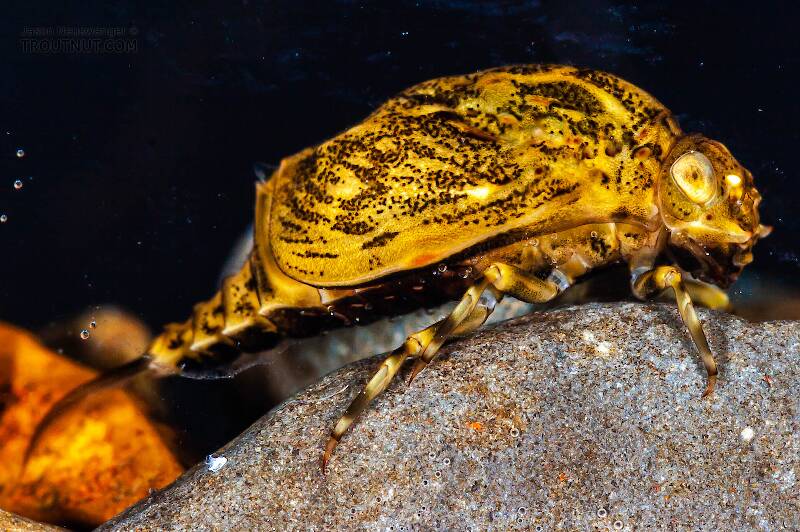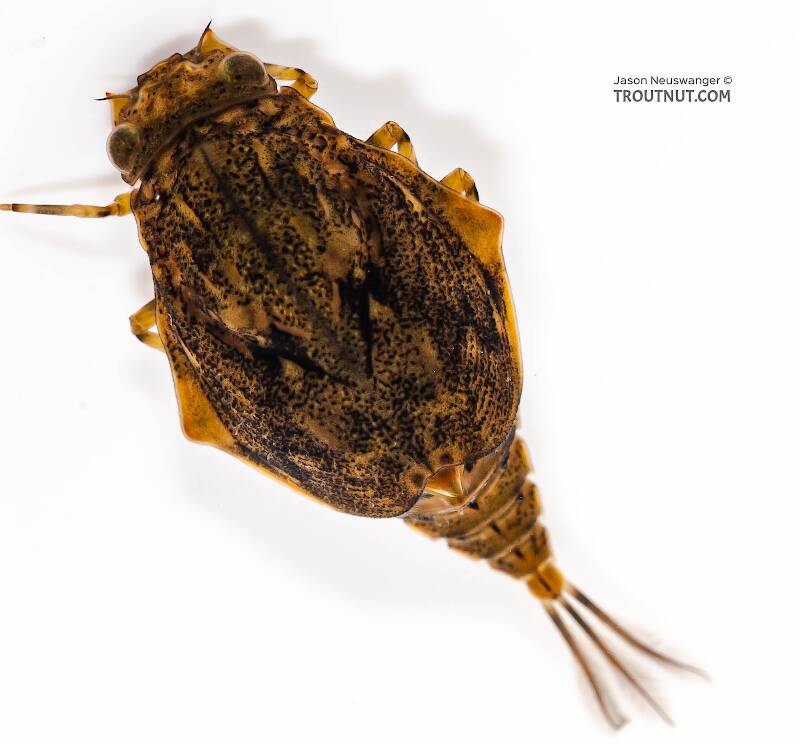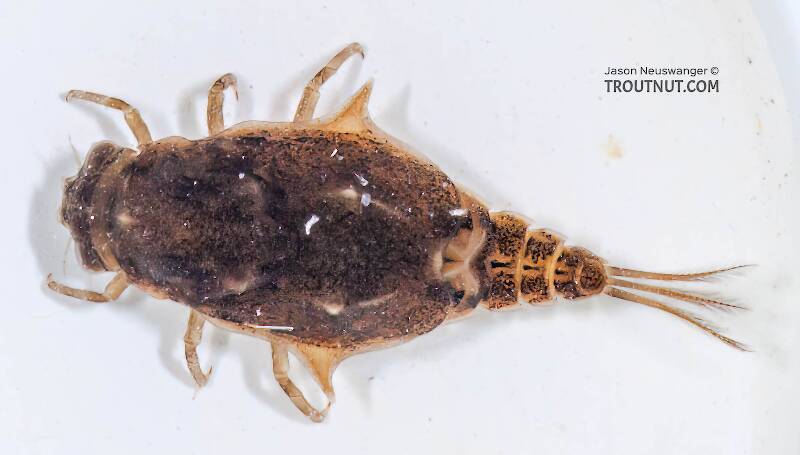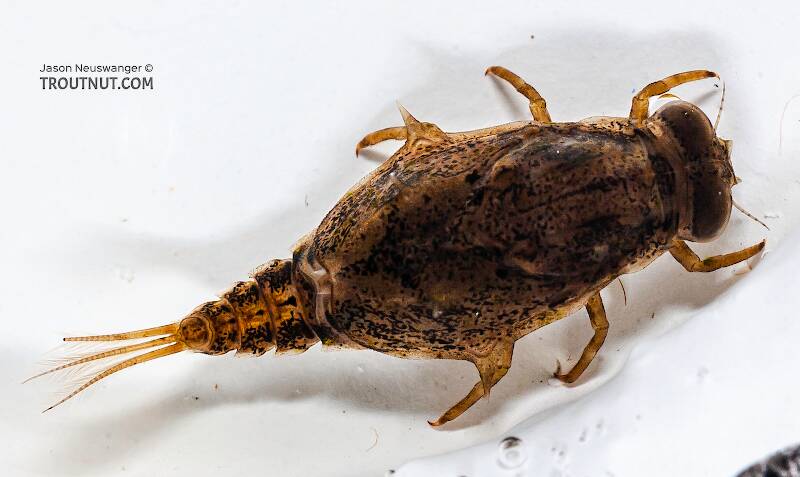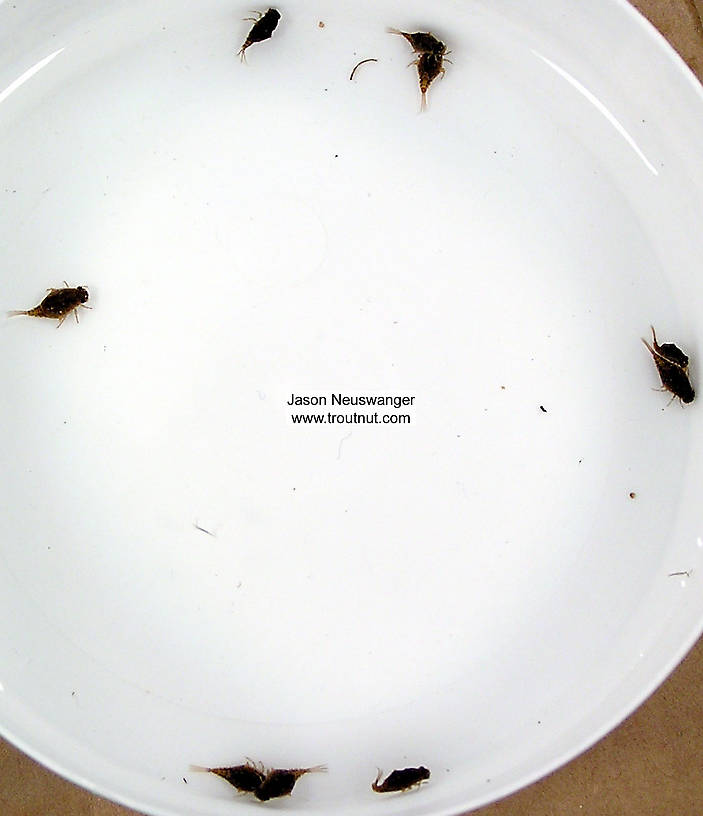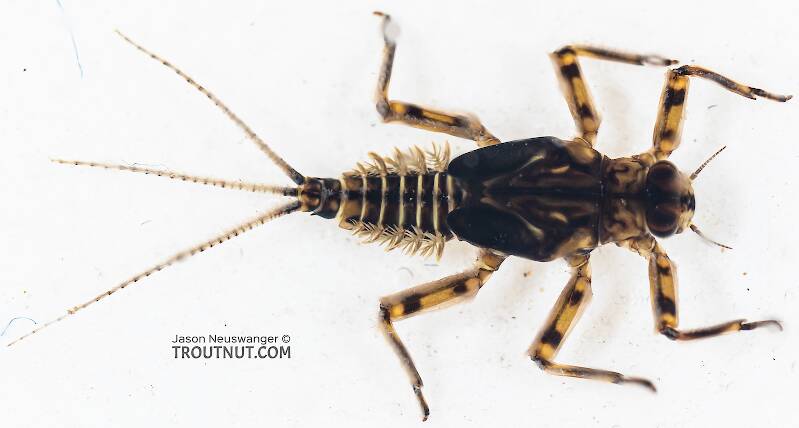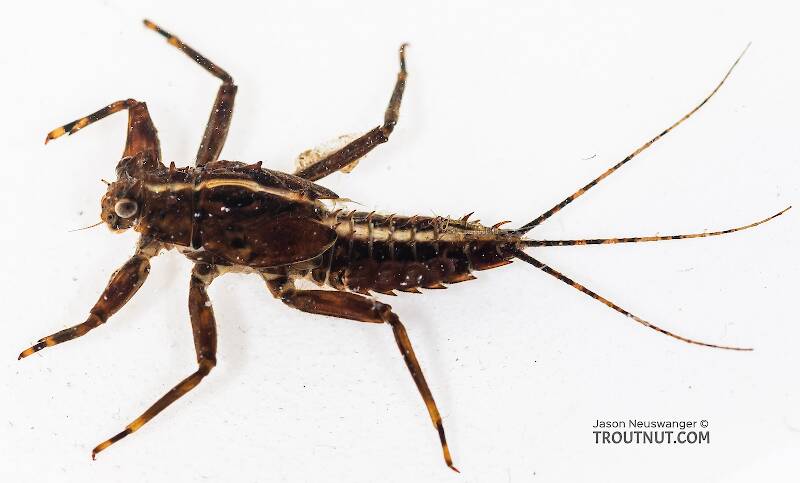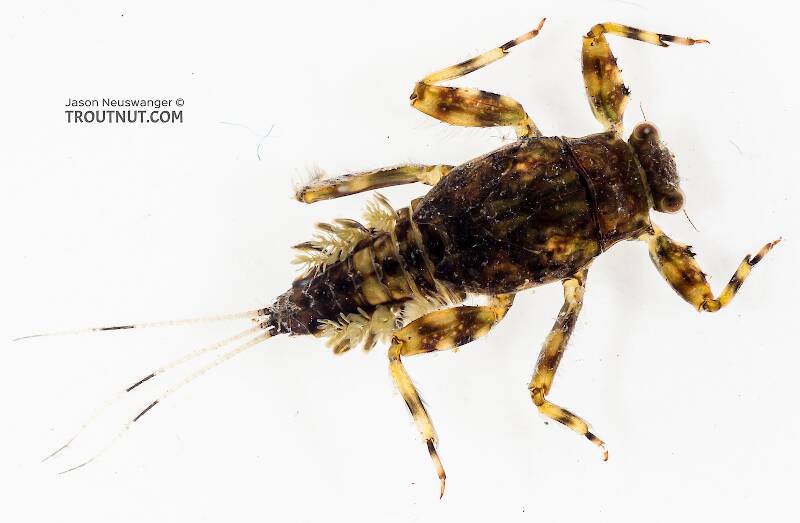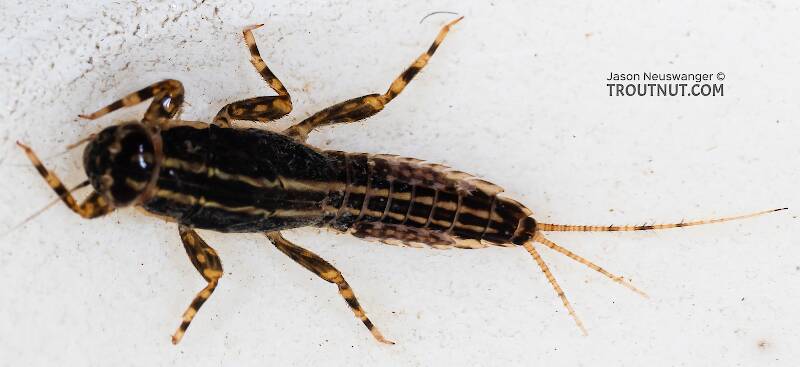
Blue-winged Olives
Baetis
Tiny Baetis mayflies are perhaps the most commonly encountered and imitated by anglers on all American trout streams due to their great abundance, widespread distribution, and trout-friendly emergence habits.
Featured on the forum

Troutnut is a project started in 2003 by salmonid ecologist Jason "Troutnut" Neuswanger to help anglers and
fly tyers unabashedly embrace the entomological side of the sport. Learn more about Troutnut or
support the project for an enhanced experience here.
Identification: Easy Angler's Key to Common Mayfly Nymphs, Couplet 10
Identification: Easy Angler's Key to Common Mayfly Nymphs, Couplet 10
| Option 1 | Option 2 |
|---|---|
Thorax expanded into a large, rounded shield, reminiscent of a turtle shell, which covers the gills 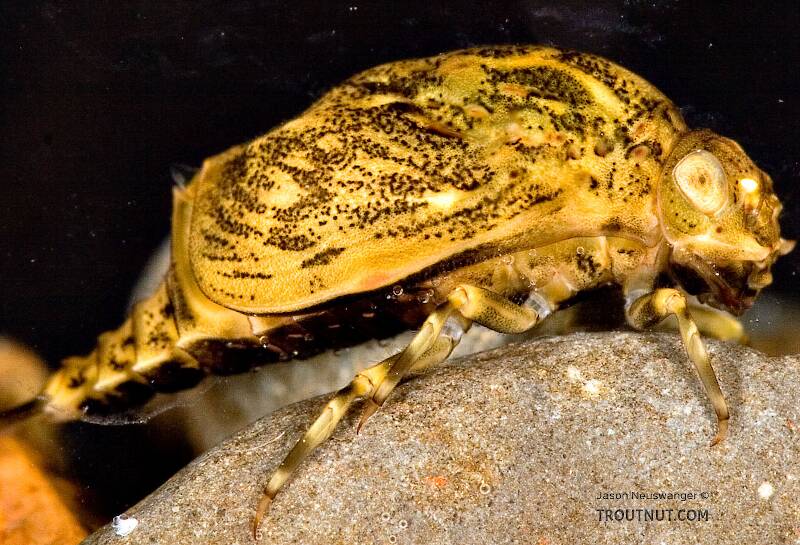
| Thorax not expanded into a turtle-like shell; gills visible on at least some abdominal segments 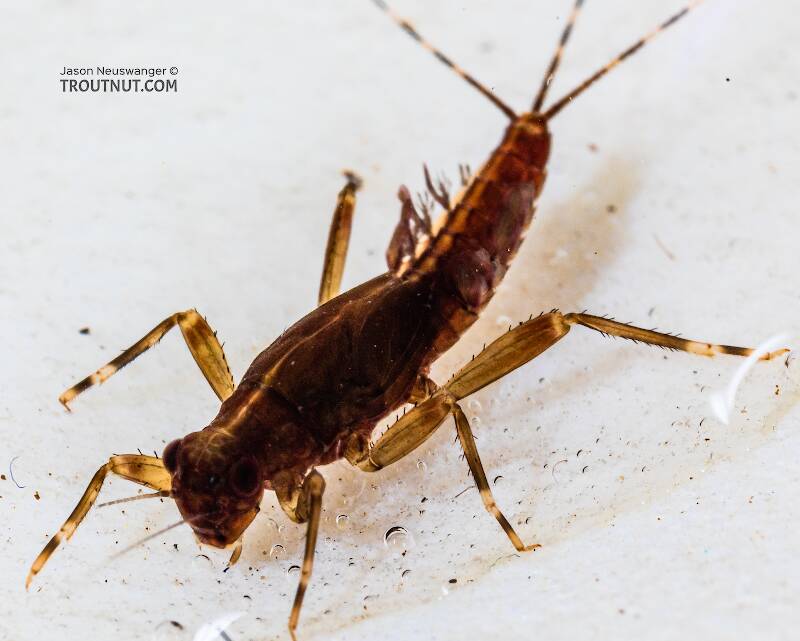
|
| Uncommon, but locally abundant on some trout streams | Very common |
| Remaining families: Caenidae, Ephemerellidae, Heptageniidae, Leptohyphidae, and Leptophlebiidae | |
5 Example Specimens | 5 Example Specimens |
| Baetiscidae | Go to Couplet 11 |
Adapted from Caucci, Al (2011) and Merritt R.W., Cummins, K.W., and Berg, M.B. (2019)
The current couplet is highlighted with darker colors and a icon, and couplets leading to this point have a icon.
Leads to Couplet 2:
- Abdomen fairly long, so the tips of the wingpads are clearly closer to the front of the head than to the base of the tails in most species
- Includes most "burrower" and "swimmer" nymphs
Couplet 2
Leads to Couplet 10:
- Abdomen short by comparison, with the tips of the wingpads being closer to the base of the tails than to the front of the head, or about the same distance from each
- Includes most "clinger" and "crawler" nymphs
Couplet 10
Leads to Couplet 3:
- Head has obvious tusks
- Gills feathery, with many fine tendrils
- Body most often yellowish
Couplet 3
Leads to Couplet 5:
- Head usually without tusks
- Gills usually plate-like, although there may be multiple plates or forks
- Body more likely a shade of gray, olive, or brown
Couplet 5
Leads to Potamanthidae:
- Gills held out to the sides of abdomen. I haven't had the opportunity to photograph any of these uncommon mayflies, but a good photo can be found on Jan Hamrsky's Flickr.
- Fairly uncommon
- Length 8–16 mm when mature
Leads to Couplet 4:
- Gills usually held more vertically above abdomen, although they can flex and wave out to the side
- Very common
Couplet 4
Leads to Ephemeridae:
- Tips of tusks curve upward when viewed from the side
- Very large when mature (12–35 mm)
Leads to Polymitarcyidae:
- Tips of tusks curve downward when viewed from the side
- Smaller when mature (9–14 mm)
Leads to Leptophlebiidae:
- Each gill is forked into two sharp, distinct branches
Leads to Couplet 6:
- Gills not forked into two sharp branches, although they sometimes have rounded lobes
Couplet 6
Leads to Couplet 7:
- Gills simple and single (one plate on each side of each abdominal segment)
Couplet 7
Leads to Couplet 8:
- Gills more complex, especially on the first few abdominal segments, with each attachment point having either two plates or a plate and a feathery tuft beneath it
Couplet 8
Leads to Ameletidae:
- Gills with a bold dark line stretching from end to end, roughly parallel and often very close to the edge of the gill
- Tails clearly fringed with fine hairs
Leads to Isonychiidae
(Isonychia):
(Isonychia):
- Forelegs with a thick, basket-like fringe of hairs
- Each gill with a filamentous tuft at its base
- Usually has a pale dorsal stripe, very vivid in some specimens, more diffuse in others
- Usually dark reddish brown color
Leads to Couplet 9:
- No thick basket-like fringe of hairs on forelegs
- Each gill with a pair of plates sharing the same base, often most obvious on the first few abdominal segments
- Wide variety of markings, but not a pale dorsal stripe
- Color more likely grayish-tan or olive
Couplet 9
Leads to Siphlonuridae
(Siphlonurus):
(Siphlonurus):
- Body relatively large, 9–17 mm when mature
- Found more often in rivers, although usually in slower habitats
Leads to Baetidae
(Callibaetis):
(Callibaetis):
- Body smaller, 6–10 mm when mature
- Found more often in lakes, although sometimes abundant in slow-moving river habitats
Couplet 10 (You are here)
Leads to Baetiscidae:
- Thorax expanded into a large, rounded shield, reminiscent of a turtle shell, which covers the gills
- Uncommon, but locally abundant on some trout streams
Leads to Couplet 11:
- Thorax not expanded into a turtle-like shell; gills visible on at least some abdominal segments
- Very common
Couplet 11
Leads to Heptageniidae:
- Head distinctly wider than abdomen
- Body and especially head typically flattened, with eyes and antennae on the dorsal surface of the head
Leads to Couplet 12:
- Head about as wide as the abdomen or less
- Body profile closer to cylindrical, not flattened
Couplet 12
Leads to Leptophlebiidae
(Leptophlebia):
(Leptophlebia):
- Broad, leaf-like, double gills on each side of each abdominal segment
Leads to Couplet 13:
- Gills single, or with a plate and feathery tuft beneath it, but not two plates
Couplet 13
Leads to Couplet 14:
- Large, operculate gills attached to abdominal segment 2 extend about half the length of the abdomen
Couplet 14
Leads to Ephemerellidae:
- Most gills are smaller and plate-like with branched tufts beneath However, a few species have enlarged gills attached to abdominal segment 4
Leads to Leptohyphidae:
- Large, operculate gill covers triangular
Start a Discussion of this Couplet
References
- Caucci, Al. 2011. The Mayfly Guide. Scott & Nix, Inc.
- Jacobus, L. M., Wiersema, N.A., and Webb, J.M. 2014. Identification of Far Northern and Western North American Mayfly Larvae (Insecta: Ephemeroptera), North of Mexico; Version 2. Joint Aquatic Science meeting, Portland, OR. Unpublished workshop manual. 1-176.
- Merritt R.W., Cummins, K.W., and Berg, M.B. 2019. An Introduction to the Aquatic Insects of North America (Fifth Edition). Kendall/Hunt Publishing Company.
Families excluded
These families of Ephemeroptera are not included in this key: Metretopodidae, Behningiidae, Neoephemeridae, Acanthametropodidae, Ametropodidae, Arthropleidae, Oligoneuriidae, Pseudironidae, Euthyplociidae, Palingeniidae
Description of this key
This key is helps identify common mayfly nymphs using characteristics that are relatively easy to see and interpret. It omits some rare mayflies and uses characteristics that aren't 100 % reliable, but it will put anglers close to the right answer most of the time. However, when accuracy is critical, you should use the full Key to Families of Mayfly Nymphs.



